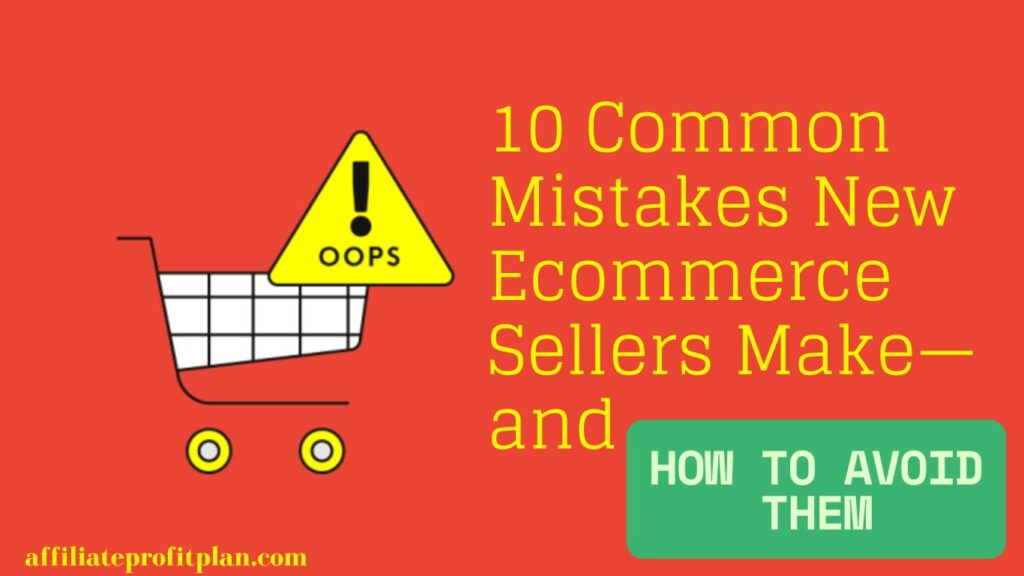Welcome to my article 10 Common Mistakes New Ecommerce Sellers Make—and How to Avoid Them. So, you’ve decided to start an ecommerce business. Congratulations! You’ve officially entered a world where your living room can double as a fulfillment center, and product photos are taken with more care than your last family portrait. The barrier to entry has never been lower—which is both a blessing and a curse. With tools like Shopify, Etsy, and WooCommerce, launching an online store can happen faster than your next Amazon delivery. But just because it’s easy to start doesn’t mean it’s easy to succeed.
In this post, we’re going to break down 10 common mistakes new ecommerce sellers make and, more importantly, how you can dodge them like a pro. Whether you’re selling handmade candles, drop-shipping cat pajamas, or launching your own apparel brand, this guide will help you skip the growing pains and get to the good part—actually making money. Let’s dive in and make sure your ecommerce story has fewer facepalms and more “cha-ching” moments.
Access My Proven Blueprint for $50-$100 Daily Income – Watch This FREE Video Now >>>

🧭 Planning & Research Mistakes
Starting an ecommerce store without a plan is like going on a road trip with no GPS, no snacks, and a car that might explode when you hit 40 mph. Sure, you might get somewhere eventually, but not without some unnecessary suffering. Two of the biggest culprits in this phase? Choosing the wrong niche and totally winging it when it comes to your target audience.
🚫 Mistake #1: Picking a Niche Based on Vibes (Not Data)
A lot of beginners pick a niche the same way they pick a Netflix show—whatever looks interesting in the moment. But “interesting” doesn’t always mean profitable. Just because you love artisanal soap for alpacas doesn’t mean there’s a thriving market waiting with open wallets.
The fix: Do your homework. Use tools like Google Trends to see if anyone is actually searching for your product idea. Hop on Amazon, Etsy, or TikTok to scope out demand and competition. Ask yourself: Are people buying this? Are they still buying this? And is there room for me to offer something better, different, or more niche?
🎯 Mistake #2: Not Knowing Who You’re Selling To
If your answer to “Who’s your target customer?” is “Um…everyone?”—we need to talk. You can’t market your product to everyone and expect anyone to care. Even Amazon started by selling just books.
The fix: Build a customer persona. What do they want? What keeps them up at night (besides scrolling Instagram)? What platforms do they hang out on? Speak to that person directly—because when you try to please everyone, you usually end up pleasing no one (except maybe your mom, who still thinks your website looks nice).
💻 Website & Tech Mistakes
So you’ve picked your niche, figured out who your dream customer is, and now you’re ready to build your online empire. But wait—before you go wild with fonts and colors, let’s talk about some of the biggest tech slip-ups that quietly kill sales faster than a pop-up ad in 2007.
🐢 Mistake #3: A Website That Loads Slower Than Your Wi-Fi in 2003
In ecommerce, speed is everything. If your site takes more than three seconds to load, most people will bail faster than a browser popup saying “Download Flash Player.” A slow site doesn’t just annoy users—it tanks your SEO, destroys your bounce rate, and makes you look less legit than that guy selling Rolexes out of his trunk.
The fix: Compress your images (you don’t need billboard-sized photos of your cat-themed coffee mugs), use a lightweight theme, and pick a solid hosting provider. Tools like GTmetrix . com or PageSpeed Insights will show you exactly what’s slowing you down. Speed isn’t a luxury—it’s a necessity.
📱 Mistake #4: Forgetting About Mobile (AKA Where All Your Customers Are)
Here’s a fun stat: Over 70% of ecommerce traffic now comes from mobile devices. And yet, some online stores still look like they were built in Microsoft Paint when viewed on a phone. Buttons are too small, text gets cut off, and the checkout process is basically an IQ test. Spoiler: no one wants to struggle that much to buy a $20 T-shirt.
The fix: Design mobile-first. That means testing everything—your homepage, product pages, and especially your checkout—on multiple screen sizes. If it’s clunky, confusing, or ugly on mobile, fix it before you launch. Your customers (and your conversion rate) will thank you.
📣 Marketing & Visibility Mistakes
So your website’s up and running, looking all shiny and professional. You’ve posted your first product, maybe even convinced your cousin to buy one “for exposure.” Now comes the hard part: getting real people to find you, trust you, and give you money. Easier said than done—especially if you’re making one of these rookie marketing mistakes.
Access My Proven Blueprint for $50-$100 Daily Income – Watch This FREE Video Now >>>
🕵️♂️ Mistake #5: Ignoring SEO Like It’s Your Ex’s Texts
Search Engine Optimization (SEO) might sound like nerdy wizardry, but it’s one of the cheapest, most powerful ways to bring consistent traffic to your store. And yet, so many new sellers completely skip it, thinking, “I’ll just run ads instead.” Spoiler alert: Ads get expensive real fast—and they stop working the moment you stop paying.
The fix: Start with the basics. Use keywords in your product titles, meta descriptions, and image alt tags. Write blog posts that answer questions your ideal customer might Google (like “How to choose the best eco-friendly yoga mat”). You don’t need to be an SEO ninja—just be intentional. The algorithm rewards effort.
🧨 Mistake #6: Relying on One Traffic Source to Rule Them All
Instagram is great…until the algorithm decides to bury your posts under 37 reels of dogs in sunglasses. Many ecommerce newbies put all their eggs in one basket—usually social media or paid ads—and then panic when engagement tanks or ad costs spike.
The fix: Diversify like your business depends on it (because it does). In addition to social media, build an email list (it’s still gold), invest in SEO, explore Pinterest if it fits your niche, and don’t underestimate word-of-mouth or affiliate marketing. A multichannel approach builds resilience—and keeps you from crying every time your reach drops.
🛠️ Operational Mistakes
Running an ecommerce store isn’t just about flashy product pages and viral TikToks—it’s also about boring but important stuff like shipping rates, inventory counts, and not accidentally selling 200 units of something you don’t have. It’s not glamorous, but if you mess this part up, no amount of branding can save you from customer emails that start with “Um, excuse me…”
📦 Mistake #7: Underestimating Shipping & Fulfillment Costs
Shipping is one of those things new sellers often treat like an afterthought—until they realize that sending a hoodie to Australia costs more than the hoodie itself. Or they offer “free shipping” without realizing they’re giving away their profit margin along with it.
The fix: Do the math before you launch. Use shipping calculators from carriers like USPS, UPS, or DHL to get real numbers. Consider using fulfillment services (like ShipBob or Amazon FBA) if you’re scaling. If you must offer free shipping, build it into your product price so you’re not losing money with every order. Customers love free shipping—but your wallet doesn’t love surprises.
📊 Mistake #8: Treating Inventory Like a Guessing Game
Nothing says “professional brand” like having your best-selling item go out of stock for two weeks because you forgot to reorder. Or worse, selling items that don’t exist and then having to send a groveling apology email that starts with “due to high demand…” (translation: “I forgot to check my stock.”)
The fix: Start with a manageable number of SKUs and track everything—even if it’s just in a spreadsheet at first. As you grow, upgrade to proper inventory management software like Ordoro, Zoho, or even Shopify’s built-in tools. And remember: it’s better to sell out and restock quickly than to over-order and end up with 400 unsold novelty mugs in your closet.
💬 Customer Experience Mistakes
Here’s the truth: you can have the best product, the most beautiful website, and marketing that would make Don Draper weep—but if your customer experience is trash, people will remember that. In ecommerce, reputation spreads faster than a meme, and nothing kills a brand quicker than being known as “that store that never replied to my email.”
🧾 Mistake #9: Not Having a Clear Return or Refund Policy
“Sorry, no returns” might work if you’re selling concert tickets or hot dogs—but in ecommerce, that’s basically telling customers, “I don’t trust you, and you probably won’t like this.” A vague, confusing, or completely missing return policy is one of the fastest ways to scare people off.
The fix: Create a return/refund policy that’s clear, fair, and easy to find. Even better? Make it sound human. Something like, “If you’re not thrilled, we’re not either—reach out within 30 days and we’ll make it right.” That kind of confidence builds trust and shows that you actually stand behind what you sell.
🙈 Mistake #10: Offering Customer Support That’s Basically a Black Hole
Ever emailed a brand and heard nothing for days? Or worse, got a robotic reply that didn’t even answer your question? Yeah—don’t be that store. People have questions, things go wrong, and your support system can either turn a mistake into loyalty—or fuel a spicy one-star review.
The fix: Even if it’s just you, set up an organized system for responding to customer inquiries quickly. Use tools like HelpScout, Zendesk, or even a dedicated Gmail and canned responses. Add a chatbot or FAQ for common questions. Bonus points if you throw in a little personality—customers love feeling like they’re talking to a real human, not a brick wall in a customer service hat.
🎉 Conclusion: Learn Fast, Fail Less, and Keep Going
Here’s the deal: every ecommerce seller makes mistakes. Some of us ship the wrong product, forget to turn off test mode at checkout (whoops), or discover—mid-launch—that our “hot product” already exists on Amazon for half the price. It’s part of the game.
Access My Proven Blueprint for $50-$100 Daily Income – Watch This FREE Video Now >>>
The trick isn’t to be perfect—it’s to be aware. If you can dodge these 10 common traps early on, you’re already ahead of most new sellers. You’re building not just a store, but a business that’s designed to last longer than your average online trend. You’re setting yourself up for happy customers, smoother operations, and fewer late-night Google searches like “how to fix broken Shopify theme without crying.”
So whether you’re still sketching out your product ideas or knee-deep in your first sales, keep learning, keep testing, and don’t panic when things go sideways—they will, occasionally. That’s ecommerce. The key is to mess up less each time.
Now go forth, optimize that store, and turn those cha-ching sounds into a regular soundtrack. And hey—if you found this helpful, stick around. There’s plenty more ecommerce goodness where this came from.
Thanks a lot for reading my article on “10 Common Mistakes New Ecommerce Sellers Make—and How to Avoid Them” till the end. Hope you’ve helped. See you with another article.










